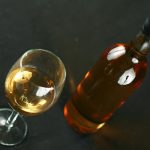Homemade Banana Wine Recipe
This wine is NOT a short term project - it will be technically potable at first, but really smooths out and becomes a lovely wine after about a year of aging. It’s worth the wait - and is one of the most popular recipes on this blog!
Servings: 4 Gallons (Approx)
Calories: 10078kcal
Equipment
- 7.5 gallon pot (or bigger)
- 1 6.5 gallon fermenter bucket and lid
- 1 or 2 6.5 gallon glass carboys & stoppers
- 1 air lock and stopper
- Siphon, siphon tubing.
Ingredients
- 21 lbs RIPE bananas Washed and sliced into thin rings
- 5 gallons Bottled water You won’t use it all
- 15-20 lbs White and/or Brown sugar We used white
- 6 teaspoon Acid Blend
- 5 teaspoon Pectinase
- 1.25 teaspoon Wine Tannin
- 6 teaspoon Yeast Nutrient
- 4 lbs Golden Raisins
- 1 packet Wine Yeast We like Red Star “Champagne” for this recipe
- Potassium sorbate or other wine stabilizer
Instructions
- In large stock pot – we used a 7.5 gallon turkey fryer – combine bananas, sugar, and about 4 gallons of water. Heat to almost boiling, mashing and stirring until sugar is dissolved. Continue to heat for about 45 minutes – never allowing it to come to a boil – stirring every few minutes. Remove from heat, add acid blend, pectinase, tannin, and yeast nutrient. Stir well.

- Place raisins in a freshly sanitized 6.5 gallon fermenting bucket. Carefully strain hot banana liquid into the fermenting bucket, over top of the raisins. Top with water to 6 gallons, and add a few scoops of the banana mush. Cover with sanitized lid and air lock, allow to cool to room temperature (overnight).

- The next morning, give the mixture a quick stir with a sanitized paddle, and – using sanitized equipment – take a gravity reading. Keep track of the number! (This is an optional step, but will allow you to calculate your final ABV %)
- Sprinkle yeast into fermenter, cover with sanitized cover and air lock. Within 48 hours, you should notice fermentation activity – bubbles in the airlock, carbonation and /or swirling in the wine must. This means you’re good to go!
- Let sit for about a week, stirring (sanitized paddle!) Every couple of days or so. It will get black on top. It’ll look awful… and your whole brewing area / basement / garage will smell like banana bread!
- After a week or so, use your sanitized siphon setup to rack the must into a freshly sanitized 6.5 gallon carboy. (At this point, we ran the raisins and remaining pulp through a juicer and added it to the carboy, but that’s entirely optional. Will give the wine extra body if you do it!)
- Put the carboy somewhere cool (not cold!), and leave it alone for a month or so.
- Using sanitized equipment, rack the banana wine off the sediment, into a clean, freshly sanitized 6.5 gallon carboy. (At this point, we added 4 lbs sugar for added sweetness. It probably also upped the final ABV!). Cap with sanitized airlock, leave it alone for another 2-3 months.
- By this point, you’ll find that your wine has clarified, and looks NOTHING like it did when it started. Enjoy your handiwork. Rack one more time, leave it for another 3 months or so.

- When your wine has been racked a few times and shows NO more fermenting activity for a month or so (no bubbles in the airlock, no more sediment being produced, you can move on to bottling.
- Follow the instructions on your selected type of wine stabilizer to stop fermentation. For potassium sorbate, this needs to be done 2-3 days before bottling.
- Using sanitized equipment, take a gravity reading, then rack the wine into clean, sanitized bottles. Cork.
- I’m not going to lie – the wine you bottle is going to be pretty harsh. Drinkable, but definitely banana flavored fire water. Put the bottles into the cases they came in and forget about them for a year (or two!) – you’ll have a much tastier wine at the end of the wait!
Notes
IMPORTANT:
Software generates nutritional information based on the ingredients as they start, and is unable to account for the sugars consumed in the fermentation process. As such, the calories, sugars, and carbs are shown WAY higher than reality.
Additionally, the listed value is for the entire recipe, NOT per serving.
Nutrition
Calories: 10078kcal | Carbohydrates: 2606g | Protein: 42g | Fat: 10g | Saturated Fat: 3g | Sodium: 333mg | Potassium: 11960mg | Fiber: 81g | Sugar: 2257g | Vitamin A: 1524IU | Vitamin C: 222mg | Calcium: 518mg | Iron: 15mg
